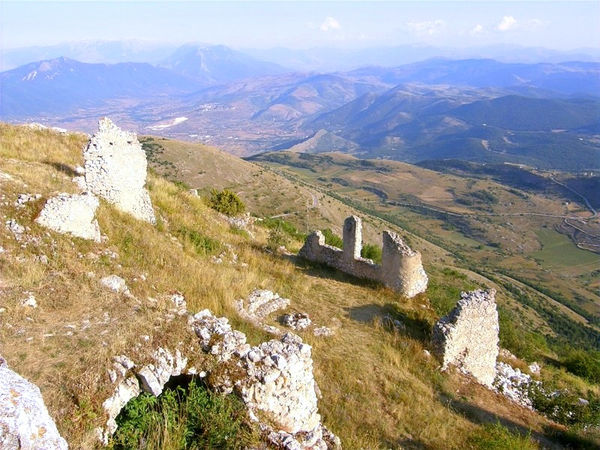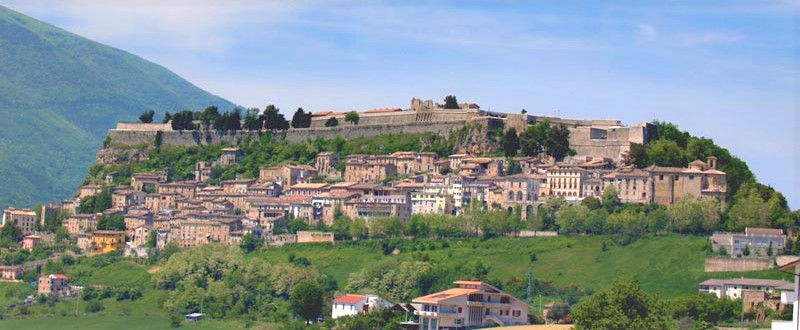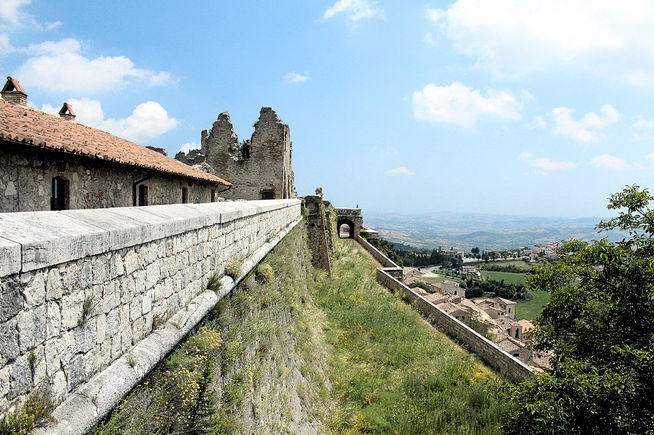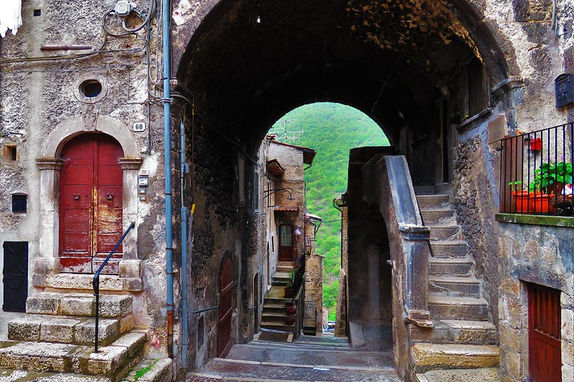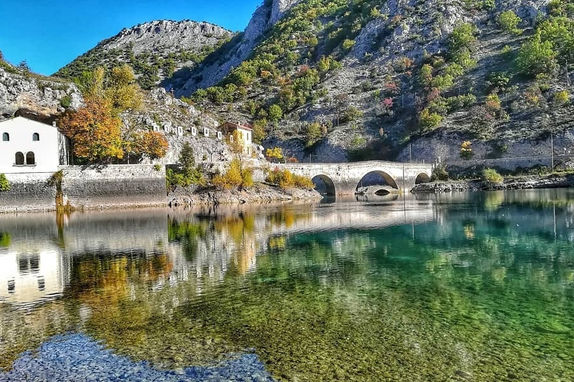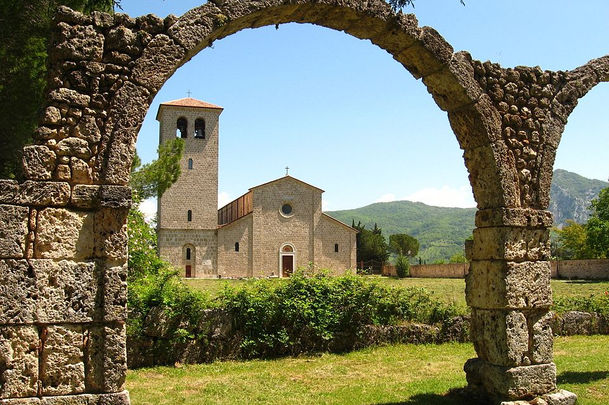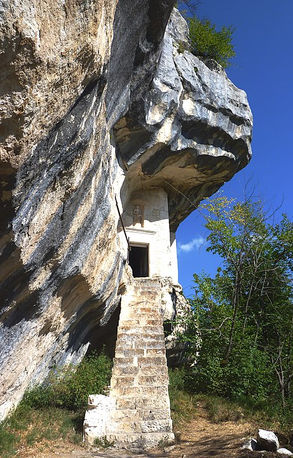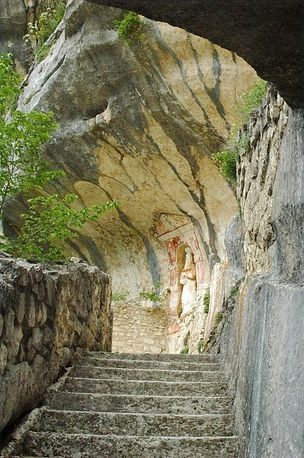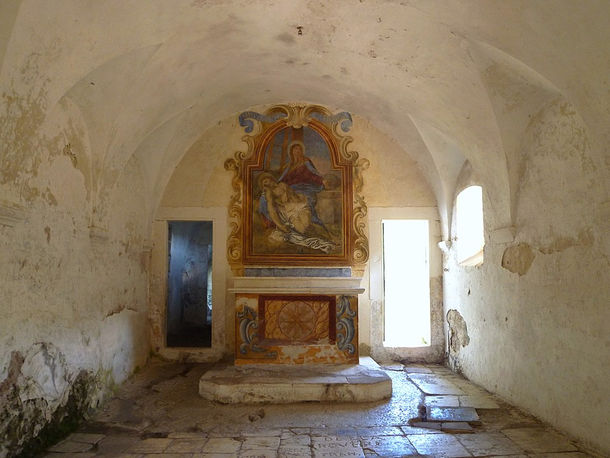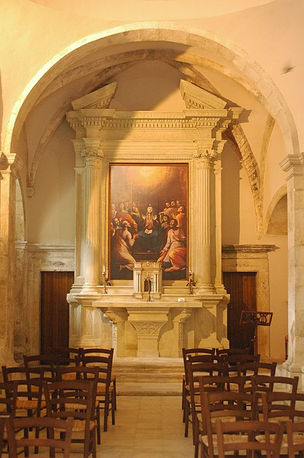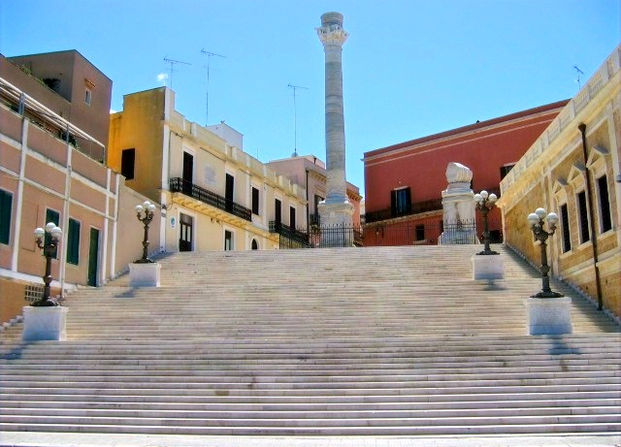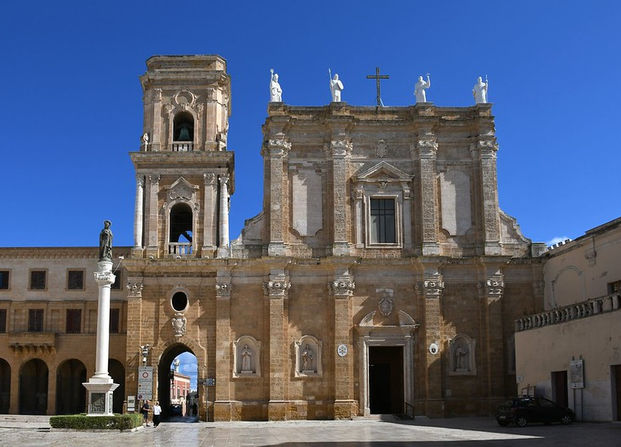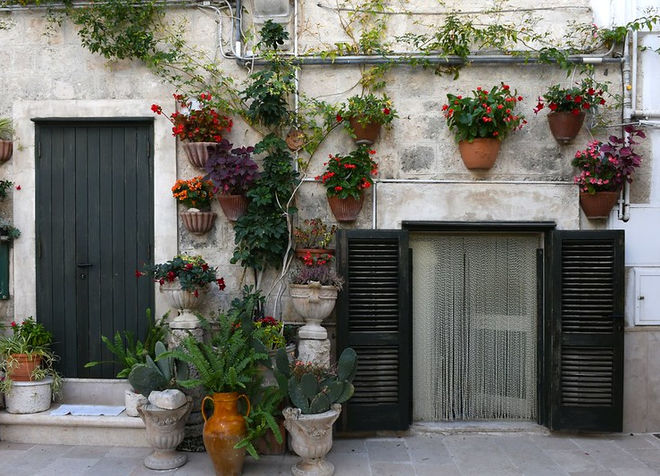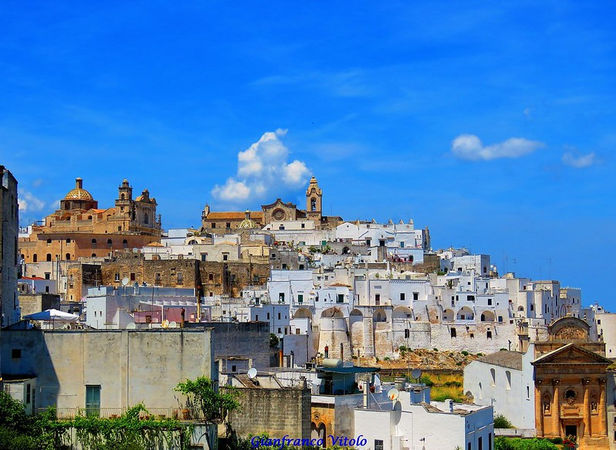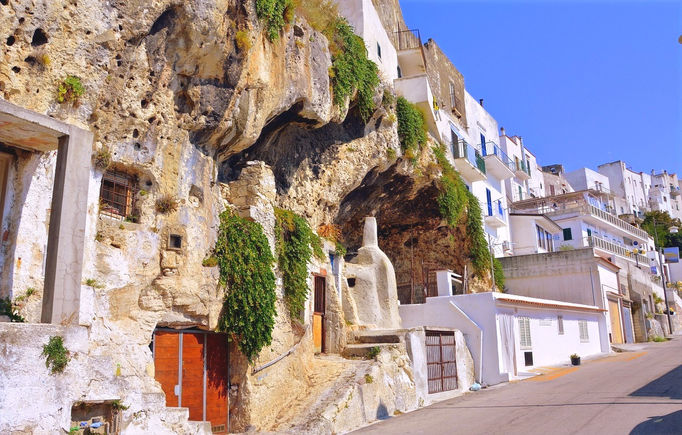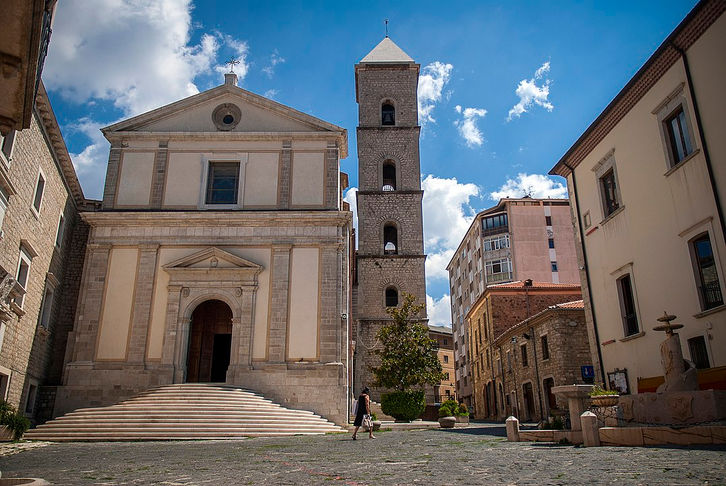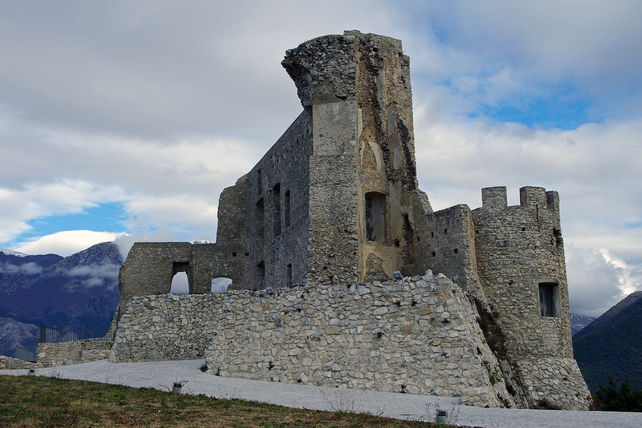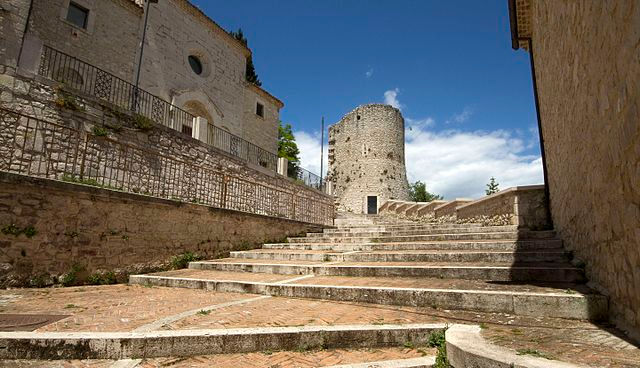

Southern Italy ,offen known as the Mezzogiorno ("Midday"), welcomes visitors with vistas of beautiful stretches of dramatic coastline, turquoise blue Tyrrhenian sea, charming quaint village, amazing archaeological sites , towering cliffs , yellow lemon groves and the perfect Mediterranean climate. It is one of the most enchanting coastline in Europe.
South Italy encompasses six of the country’s 20 regions:
Abruzzo, Apulia, Basilicata, Calabria, Molise and Campania
Southern Italy
The UNESCO World Heritage Sites in these regions are:
Basilicata
-
The Sassi and the Park of the Rupestrian Churches of Matera
Puglia
-
Castel del Monte
-
Sanctuary of San Michele (Longobard Site)
-
The Trulli of Alberobello
Campania (see Campania and Amalfi Coast)
So if you’re tired of the same-old same-old city tours of Rome or Venice, why not experience the authentic South Italy?
By Valter Cirillo - Pixabay
Abruzzo
A region nestled in the Apennines and the Adriatic coast, just a couple of hours away from Rome.
Abruzzo is world-famous for its wildlife parks (Abruzzo National Park, Gran Sasso and Monti della Laga National Park, Majella National Park), one of the Italian regions where it is possible to admire a realm of unspoiled nature, perfectly merges with the beauty of the valleys, mountains and tablelands. The highest peak of the Apennines, Corno Grande is located in this region. It is a land rich in history too. Abruzzo was an important military base during the Kingdom of Naples.
Below are some of the dazzling gems not to be miss while you are in Abruzzo region.
L’Aquila
The city of L’Aquila, nestled on a hill, in the valley of the Aterno River, surrounded by the Apennine Mountains, is one of the oldest city in Italy. An earthquake that struck L'Aquila on April 6, 2009, damaged many of the city's medieval buildings. However, it has been reconstructed and many important monuments have been beautifully restored, although there is still much reconstruction going on. The main square and the main streets in the old city are buzzing with life now. Visitors spending really helps the local economy and this great city to rise again! After all L'Aquila is still worth a visit!
Some of ancient monuments that remains perfectly intact are Fountain of 99 spouts, Collemaggio Church and Saint Bernardino Church.
Fountain of 99 spouts
An unique medieval fountain, built in the 13th century, lined with 99 unique stone faces whose origins and meaning remain unknown, is an icon of the town of L'Aquila, and certainly is one of the best-known monuments in Abruzzo. The sound of flowing water is really impressive and can already be heard from afar.
Amiternum
Amiternum was an ancient Sabine city, then Roman city and later bishopric. It is located in an uncontaminated countryside iFor history buff, you can see a part of the ancient romans’ significant mark in the site of Amiternum , the remains of an amphitheatre and a great theater. This place is very well preserved and surrounded by a treasury of natural beauty. Amiternum was the birthplace of the historian Sallust.

By Lasacrasillaba -wikimedia.org
Calascio
One of the oldest standing forts in Italy, the spectacular Rocca Calascio. This is the highest mountaintop fort in Italy, 1460m above sea level. Rocca Calascio was initially built as a watchtower in the 10th century, was gradually expanded over the following centuries especially during the Medici family in the late 16th century. An earthquake badly damaged the fort in 1703, Rocca Calascio has been abandoned ever since. However, the view still exists and remains as breathtaking as it was a millennium ago.
Campotosto
A city in province of L'Aquila, has become famous in Italy for its lake, which is the biggest Italian man-made lake. It is located in the Gran Sasso e Monti della Laga National Park. Visitors usually view it from the peaks of the Alga District and the Gran Sasso. In summer the lake is a rendezvous for canoeing, windsurfing, picnicking or simple romantic walks during the sunset hours. Its height of 1313 metres above sea level guarantees a refreshing temperature. During the winter the lake freezes completely , while in autumn, many people come to admire the colorful foliage.


By Valter Cirillo-Pixabay
Castel del Monte Abruzzo
Castel del Monte, a charming village in an awesome location, which covers the top of a hill in the Gran Sasso mountain range. Around the town are strong defensive walls and five defensive gates dated from the Medici period in 16th century. Its architecture mostly medieval and Renaissance. From the village, you will have breathtaking views over the surrounding mountains. It is classified as one of the "borghi piu belli d'Italia" or "one of the most beautiful villages of Italy".
NB: Not to be confused with Castel del Monte, Puglia (Apulia), a 13th-century castle and World Heritage Site in Andria.
_jpg%2520Di%2520Ra.jpg)

Church of San Marco Evangelista
By Ra Boe - Wikipedia, CC BY-SA 3.0 de
Castelli
Castelli nested at the foot of a mountain, surrounded by the thick forests of the national park, is one of the most dramatic settings in Abruzzo. It is world famous for hand-painted ceramics, Maiolica (Majolica ), a form of brightly colored hand-painted pottery, which were collected by the nobility of Europe for centuries and are still produced today by local artists. There are plenty of shops and factories to visit, and you can make your own Majolica masterpiece while you are in Castelli!


By Pietro Valocchi-flickr-CC BY-SA 2.0
Civitella del Tronto
Civitella del Tronto is another enchanting town in the Gran Sasso e Monti della Laga National Park. It is home to the largest fortress in Italy. The Fortress of Civitella del Tronto, one of the most important engineering works on the Italian peninsula. Built from the fifteenth century by the Aragonese, later enlarged and modified by the Spanish Habsburgs and the Bourbons. It is now an interesting Museum of Weapons. It offers stunning views over three different mountain ranges, the villages and the Adriatic sea.
Chieti
The city of Chieti is also provincial capital of Chieti region. It has a stunning hilltop setting below Mt. Majella and above the Sangro Valley. It is one of the oldest cities in Italy and legend says that it was founded by Achilles and named Teate (its ancient name) in honour of his mother Thetis.
The city's history goes back to before the Roman era. Walking around the city today you can admire a large number of palazzos and churches and the remains of the Roman’s architecture, like the city gate, Porta Pescara, and the remains of the Templi Romani, theater and bath complex complete with beautiful mosaics, right in the heart of the city. Amongst the religious monuments the Cathedral of San Giustino is the largest and most important. One of the more colorful festas is the Infiorata, when the streets get carpeted in decoratively arranged flower petals in honor of Corpus Domini.
Navelli
Navelli is a beautiful hill top village, which has been classified as one of the "most beautiful villages of Italy". It is famous for its saffron production and if you visit in October or November, you will see the fields covered with lovely purple crocus flowers whose red stigmas are the prized saffron we use in our cooking. Be sure to take some home with you!
Porta San Pelino the oldest of the gateways into Navelli and the start of the oldest part of the village. Wandering through the twisting alleyways, steep stairs and paved streets, lead you to the 17th century Palazzo Santucci , where you can enjoy the manificient view of the village and valley at the top of the open galley. With the lovely golden stone houses, has been classified as one of the "most beautiful villages of Italy".
Pescara
The province of Pescara is a province in Abruzzo region and its provincial capital is is the city Pescara. Other major cities includes Caramaico Terme, Castiglione a Casauria, Picciano, Popoli and Loreto Aprutino.
The city of Pescara is a modern city bordering the Adriatic Sea with long seafront bathing areas dotted with restaurants and a long cycle path. This modern city is also known as “the city of the two bridges”, the Sea Bridge and the Flaiano Bridge, both renowned for their fabulous skyline. The Sea Bridge has become a true symbol of the city, with a length of 466 metres, it is the largest cycle-pedestrian bridge in Italy.
Pescara is popular all year round, not only for the sea and the shopping, but also for interesting archaeological finds discovered in the area, including a Neolithic village under the Orlando Hill, dating back approximately 6,000 years.
Santo Stefano di Sessanio
Santo Stefano di Sessanio is located in the mountains of Abruzzo at 1250 meters above sea level, inside the Gran Sasso and Monti della Laga national park, in the province of L'Aquila. It laid largely abandoned until 1999, a Swedish-Italian multi-millionaire, Daniele Kihlgren , happened to stumbled upon this deserted hilltop village on his motorbike trip. He was amazed not only by the outstanding beauty of the setting, but also because almost everything was untouched. His aim was to save this village from extinction, bring it back to life and welcome tourists, while maintaining original features. The city has been beautifully restored and turned into an hospitality place, comprise of hotels or vacation homes. In order to retain everything back to village life, only local materials, old furniture and artifacts were used . Modern technology, such as under floor heating and light switches are discreetly hidden.
Strolling among the alleys, stone houses and ancient buildings of Santo Stefano di Sessanio feels like a trip stepping back in time! The entrance gate to the main village square is emblazoned with the Medici coat of arms. There are elegant arcades, mullioned windows and fine balconies from the time of the Medici rulers. Unfortunately, the iconic Medici tower and the 17th century church of the Madonna del Lago were destroyed by the 2009 earthquake but most other buildings survived more or less intact. You can spend hours walking round the beautiful town, which is slowly being restored after the 2009 earthquake. (Photos are taken after the earthquake).
Scanno
Scanno, a picturesque village in the upper Saggitario Valley and is one of the highlights of any visit in the province of L'Aquila. It is in a very scenic location, surrounded by the forest covered hills of the Apennines and the peaceful Lake Scanno. The town is well known for production of pecorino cheese, a cheese made from goat milk. There is a myriad of small churches, with magnificent church spires to visit, but the Church of Santa-Maria della Valle is among the most important churches in Scanno, built in the local romanesque style and containing some medieval frescoes and impressive altar. There are numerous alleys, ancient houses with quirky ancient doors and streets to discover as you explore. Scanno is becoming quite established on the tourist trail in the region and is a popular destination in both summer and winter.
Lake of Scanno
Lake of Scanno, another fabulous place to visit in the province of L'Aquila. It is set between the Marsican mountains and the valley of the Sagittarius river. Here you will get immersed in the heart of nature, and if you pay attention, you will see that the lake has the shape of a Heart !
Villalago
Lake Scanno also touches Villalago, a tiny village located 15 minutes away from Scanno. This village sits peacefully on Mount Argonetta, its ancient buildings clinging onto the cliff face. Known for the Hermitage of San Domenico, a small church surrounded by peace and the beauty of nature. The Church of Santa Maria di Loreto in the historical center, is also a hidden gem, with its striking 15th-century doorway.
Teramo
The city of Teramo ia a historical and very charming city, founded dated to Phoenician times and it is still full of archaeological finds proving the passage of different peoples, such as funerary treasures similar to the Picene tombs. Today its monuments testify its different dominations, from Francesco Sforza to Alfonso d'Aragona, from the Spanish and the French to the Realm of Naples in the 19th century.
The Province of Teramo is characterized by the eastern side of the Apennines and by valleys gently sloping towards the Adriatic coastline and boasts seven stunning beaches on the Adriatric Seacoast, called the seven sisters, namely:
-
Martinsicuro
-
Alba Adriatica
-
Tortoreto
-
Giulianova
-
Roseto degli Abruzzi
-
Pineto
-
Silvi Marina
National Parks
National parks cover about 1/3 of Abruzzo, which is why the region is nicknamed the ‘Green Region of Europe.’
The three most popular National parks are:
-
National Park of the Abruzzo, Lazio and Molise
-
Gran Sasso and Monti della Laga National Park
-
Majella National Park
During summer, hiking trails are the ideal activity for nature lovers, hikers, or anyone who loves the great outdoors. Or you sit back, relax and let your private chauffeur driving you through the fascinating paths, to see the local fauna and wildlife of the forest landscape. You may spot some typical animal species like the Apennine wolf, the Abruzzo chamois and the Marsican brown bear.
Mountainous and park-covered terrain, Abruzzo boasts numerous ski resorts where visitors can enjoy many awesome winter sports. There are many Ski resorts , the most famous of Campo Felice, Ovindoli and Roccaraso, to those composing the legendary ski hubs of the Gran Sasso, including Campo Imperatore, Pescasseroli, Tagliacozzo and Passo Lanciano. Here, among the majestic snow-capped peaks ,endless meadows, and unspoilt nature, you can forget about the chaos of the cities!
National Park of the Abruzzo, Lazio and Molise
Gran Sasso and Monti della Laga National Park
Campo Imperatore
Campo Imperatore, meaning “Emperor's Field” is a alpine meadow formed by a high basin plateau, the largest plateau of Apennine ridge, in Gran Sasso e Monti della Laga National Park, in the province of L'Aquila. This is one of the finest mountain plains in Italy. It is also known as "Little Tibet". The high altitudes are the kingdom of the permanent snow and keep the southernmost glacier in the continent, namely the Calderone.
Campo Imperatore is also home to the Alpine Botanical Garden of Campo Imperatore, devoted to cultivation and study of some 300 species indigenous mountainous plants, including rare and endangered plant species. It is also the site of the Astronomic Observatory.
On the southeastern side of Campo Imperatore are medieval hill towns Castel Del Monte and Santo Stefano di Sessanio as well as the ruin of one of Europe's highest fortresses, Rocca Calascio.
Majella National Park
Famous for its hermitages.
The hermitage of San Bartolomeo in Legio
The hermitage of San Bartolomeo in Legio, a Centuries-old church carved from a stone cliff with a preserved fresco, altar & hermit cell. It was built in a period prior to the year 1000 and subsequently restored around 13th century by Pope Celestino V. The uncontaminated environment, the views, the silence, broken only by the sound of the waters from the flowing stream, refresh the soul deeply. Here you will feel the strength of the spirit and faith...
The route is classified as family-friendly, so you can take your children with you, and have a unique experience.
The hermitage of Santo Spirito, the Holy Spirit
The hermitage of Santo Spirito at Majella is the largest of the Majella hermitages. Where Pope Celestino V stayed until 1293. In 1807, the building was plundered and burnt down, and only at the end of the nineteenth century the restoration of the church took place. Thanks to the citizens of Roccamorice.
Today Santo Spirito hermitage has a church, a sacristy, a two stories wing and the recently renewed guesthouse, known as The Prince’s House. From the guest house, climb up the Holy Staircase, entirely carved into the rock, up to the Maddalena oratory and two large rocky balconies.
It is one of the most evocative and mystical places in the Abruzzo region.
Apulia(Puglia)
Apulia (Puglia in Italian) is located in the heel of Italy’s boot, a long, narrow peninsula, bordered by two seas, the Ionian and Adriatic, with the longest coastline in the Italian peninsula, Puglia is a stunning region of Italy.
Famous for its hobbit-like trulli, incredible coastline and turquoise seas, delicious food and beautiful rural landscapes.
Some of the major cities are Bari, the capital of Apulia. Alberobello, Andria ( Castel del Monte), Brindisi, Monopoli, Monte Sant’Angelo , Ostuni, Polignano a Mare, San Giovanni Rotondo and Vieste.
Puglia has three UNESCO World Heritage Site, namely:
-
Castel del Monte Fortress
-
The Trulli of Alberobello
-
Sanctuary of San Michele (Longobard Site)
Bari
The city of Bari, located on the Adriatic Sea, is a bustling, well-known port and university city. Bari lures visitors from across the globe, especially the youngsters as the city is filled with incredible nightlife and an internationally recognized educational institution. It is the capital of the Bari province in Apulia.
Bari boasts great architecture, stunning churches, a nice seaside promenade and a very interesting historic center, walled city built on a peninsula jutting into the sea, with narrow and winding alleyways. There are a number of buildings worth visiting. These include the Swabian Castle, which has a rich and varied history, one of the best examples of Romanesque architecture in Puglia, the Basilica of San Nicola, pilgrimage to the patron Saint of the city and is filled with convents, many churches, small shops and bakeries.
Bari was one of the most important trading towns on the Adriatic during the Roman Empire, even today, it remains the busiest passenger port in the Adriatic, with regular ferry links to the Balkans and Greece.
Alberobello
Alberobello is in the province of Bari. Its main draw is its characteristic trulli. Cute charming houses, white-tipped conical-roofed that look as if they’ve been dusted by snow. Thanks to this distinctive feature, the town is so unique that it was made a UNESCO World Heritage site in 1996. These Trulli are prehistoric buildings, made out of local white dry limestone, circular plants, with small windows and spectacular pinnacles, giving the historic center a whimsical fairytale look.
There are about 1500 Trulli , and still functional as houses,bars, hotels and shops.
Head up to Piazza del Popolo Belvedere Trulli lookout , which offers spectacular views over Alberobello and its trulli.
Andria
Andria s an agricultural center, especially the cultivation of vines, olives, and almonds. There is also wine production, oil refining, and the manufacture of textiles. It is renowned for Castel del Monte- a UNESCO World Heritage Site and the symbol of Puglia.
Castel del Monte
Situated on the peak of an isolated hill in Andria, 540 meters above sea level, overlooking the Murgia Valley on one side, and with a sweeping view of the Adriatic Sea on the other, Castel del Monte is one of the most mysterious places in Italy. An attraction that absolutely should not be passed while in Puglia. It was built by the Holy Roman Emperor Frederick II in the 13th century.
The perfectly preserved castle, is a medieval military architecture, characterized by an unusual octagon shape with octagonal towers at each corner. In 1996, it was included in the UNESCO World Heritage list for its outstanding mathematical precision of layout, with extraordinary blend of various architectural styles, from classical antiquity, the Islamic Orient, Norman to European Cistercian Gothic.
Not only the shape was remarkable, Castel del Monte also has an advanced plumbing system, which used rain water for the toilets and bathrooms of the fortress.
NB: Not to be confused with Castel del Monte Abruzzo, a village in the Province of L'Aquila, Abruzzo

By Volker Glätsch - Pixabay
Brindisi
The city of Brindisi was badly bombed during the Second World War, and spent many years rebuilding, especially in the last decade, the city has undergone a significant makeover. Take a walk along the picturesque promenade , with the Monument dedicated to Italian Sailors, known as “The Rudder” , stone structure resemble a ships rudder , one of the most iconic structures in the city. It is possible to climb to the top of it for unrivalled panoramic views of Brindisi. The outstanding Aragonese Castle, best known as Forte a Mare (Sea Fort), served as a defensive fortification and protection for the entrance of the port of Brindisi. Its beautiful waterfront is packed with restaurants and bars. The old town is filled with many winding streets, charming old building but the most important is 13th century Church of Santa Maria del Casale, one of the most beautiful and renowned religious building .
Under the Romans, Brindisi became a busy city with an active port, the chief point of embarkation for Greece and the East. It was connected with Rome by the Via Appia and the Via Traiana. Two ancient Roman pillars, symbols of Brindisi were once used to mark the ending points of the Appian Way, and were used as a port reference for the antique mariners too. Only one of the two, standing at about 18 metres, is still visible.
Foggia
Foggia, is one of the province of Puglia, and the city of Foggia is the capital of the province. Other major cities include Monte Sant’Angelo , San Giovanni Rotondo and Vieste.
Much of the city center of Foggia was destroyed in recent years either by earthquakes or by bombing during WWII. Only a door remains of Frederick II’s palace, the cathedral, with Baroque alterations, survives. The Church of the Crosses (Cheisa delle Croci ) is worth a visit. Its structure is not like the other traditional churches. At the entrance, you will find a Baroque style arch, then a path with five external chapels that will lead you to the main Church.
There is much underground here to explore, known as urban hypogea and cellars ,a maze of underground streets of medieval origin, that remind this is a city with a colourful past. You can enjoy a trip to the fascinating underground urban hypogea.
From Foggia’s you can explore parks such as Gargano, and the gorgeous Tremiti Islands.

By Morenodl - wikimedia.org, CC BY-SA 4.0
Monopoli
Monopoli a small delightful coastal town boasts many small medieval churches and countless cobblestone alleys. The octagonal castle of Monopoli, built in 16th century by the Spanish, was at that time separated from the rest of the city. Today, it is part of the city and you can enjoy stunning view from the top of the castle. Adding to the charm of this medieval old town, is an old fishing port, a series of fortified seafront walls, golden sandy cove with quiet uncontaminated beach. A fantastic place to visit to escape from the city and enjoy some quality relaxation!
Castellana Caves
A few km from Monopoli, sitting in a location with amazing geological features, you can find Castellana Grotte’s stunning rock formations and unique stalactites, began to form about 90 million years ago and it is one of the most important attractions of Puglia and natural heritage of inestimable value to Italy.
Monte Sant’Angelo
Monte Sant’Angelo is a village located in a panoramic position on Mount Gargano. It was a Norman stronghold that became a popular pilgrimage destination. The town is clustered Arab-style on the hillside where the white-washed single homes are lined up in neat rows, punctuated by low peaked rows. It is quite a sight!
The Sanctuary of San Michele Arcangelo built in the cave ( Sacra Grotta) where, in 490 A.D. San Michele Arcangelo made its appearance to a shepherd.
It fell under the dominion of the Lombards in 650 A.D. who transformed it into the main worship center.
The Sanctuary of San Michele Arcangelo has become an important pilgrims’ destination, both during the reign and after the fall of the Lombard kingdom. It has been visited, over the centuries, by millions of pilgrims, popes and sovereigns.
In 2011, it became a UNESCO World Heritage Site as part of a group of seven inscribed as Longobards in Italy and Their Places of Power (568-774 A.D.).

Monte Sant’Angelo
By sebastiano iervolino -Pixabay

Sanctuary of San Michele Arcangelo
By Mboesch - wikimedia.org, CC BY-SA 4.0
Ostuni
Ostuni, known as the ‘White City’, is a beautiful maze-like city on a hilltop, packed with gleaming whitewashed houses, medieval architectural treasures, narrow alleyways surrounded by quaint countryside, endless olive groves and dazzling views of the Adriatic coast. It's a city for those that simply like to stroll amongst beauty and spontaneous Italian moments.
Polignano a Mare
Polignano a Mare, is an idyllic seaside town on the Adriatic Sea. Perching on the edge of a craggy cliff on the Adriatic coast, Polignano a Mare is prettier than a postcard. One of the most romantic cities in the region, ideal place to plunge into uncontaminated waters, relax and unwind on a laid-back vacation. The high cliffs and jagged coastline, make Polignano's shoreline one of Puglia's most beautiful coastal stretches, with hidden inlets and charming sandy bays. Thanks to its spectacular setting, surrounded by crystal clear waters and half-submerged sea caves, Polignano a Mare is widely famous throughout the world for cliff diving.
Head through the Arco della Porta, you will find the fascinating historical centre, reveals traces of its Arab, Byzantine, Spanish and Norman past, including the remains of the four watchtowers that once guarded the ancient town. Labyrinth-like winding streets, alleyways, sun-bleached buildings, charming churches and glimpses of sparkling blue sea greets your eyes wherever you gaze.


By Gianfranco Vitolo - flickr CC BY 2.0
San Giovanni Rotondo
San Giovanni Rotondo was the home of Saint Pio of Pietrelcina from 28 July 1916 until his death on 23 September 1968. The Padre Pio Pilgrimage Church was built in devotion to the saint and dedicated on 1 July 2004. The town is renowned for a large hospital and research center, founded by Padre Pio.
A Catholic shrine in San Giovanni Rotondo, built in devotion to Saint Pio of Pietrelcina, it can accommodate 6,500 people seated at worship, with standing room for 30,000 people outside. It is located in front the hospital and research center.


By Go Travelling, Public Domain
Salento Peninsula
A sun-kissed territory all year round, Salento is a haven for sea lovers. Covering 3 provinces of Puglia, (Brindisi , Taranto and Lecce), it is home to some of Italy's loveliest beaches and most dramatic rocky coastline, with is a vast strip of paradisiacal golden sand and transparent azure waters. The area boasts a fabulous landscape, ranging from the Adriatic coast to the Ionian Sea and the golden beaches of Porto Cesareo, Portoselvaggio and Gallipoli . It is home to small and charming towns as Gallipoli, Otranto and Lecce and has many small hamlets off the tourist track, greatly worth visiting their unspoilt historic centres and their beautiful coastline with dazzling aquamarine waters.
Lecce
It’s a hidden gem of the Salento peninsula. Known as “Florence of the South”, this charming city is a must-see when you are in Apulia. Lecce is known as a Baroque city, as its history goes back to 16th century , under the ruling of the Spanish Empire which the Baroque architecture flourished.
The historical center boasts numerous churches and squares, such as the cathedral is nestled in the corner of the Piazza del Duomo, and the Basilica di Santa Croce fame for its elaborate Baroque façade. The Roman amphitheatre located in the Piazza Sant’ Oronzo, is also worth a visit“Florence of the South”, this incredibly charming city is one of the must-see places in Puglia. The city is built in its unique local honey-hued stone that form a splendid backdrop to the historical center.
Trani
Trani is a seaport of Apulia, on the Adriatic Sea. It is the capital city of the Province of Barletta-Andria-Trani.
Wandering along the charming mediaeval lanes,and admire harbour views, flanked with plenty of fine architectures, around the picturesque fishing port. One of the important sight is the Cathedral of Saint Nicholas the Pilgrim, which dominates the seashore from a spectacular position at the water's edge. Next, the defensive fortress, located on the shore just beyond the cathedral. It was built in 13th century, one of the many castles built in southern Italy built by the Holy Roman Emperor Frederick II.
Tremiti Islands
Situated off Gargano’s coastline, this is a group of islands are truly pearls to be discovered, lot of tranquility, with incredible unspoilt scenery and wildlife. San Domino and San Nicola are the main inhabited islands and provide most of the facilities for tourists. San Domino is the largest of the island. You can reach the Tremiti Islands via a ferry from Termoli or Rodi which are both coastal towns approximately 30 minutes from the city of Foggia. Explore the islands on foot, admire the rugged landscapes or explore the coastal caves. Diving is a popular pastime here due to the beautifully clear waters and abundance of aquatic life.
Vieste
Vieste is a coastal town in Gargano National Park. It’s splendid coastline is lined with sea caves, grottoes, and secluded sun-drenched coves waiting to be explored. It is home to the imposing Pizzomunno limestone monolith. Marine fossils and rare shells are on display at the Museum of Malacology. The town is encircled with whitewashed limestone walls and has the same labyrinthine historic core of pretty cobblestone streets, colorful piazzette, and blanched buildings with flower-filled wrought-iron balconies.
Basilicata
Basilicata is a very mountainous region. Because of this, communication in the area was very difficult until modern times. This has also caused Basilicata to be one of the least developed regions of Italy. Basilicata borders the Tyrrhenian Sea and the Gulf of Taranto at its lowest elevations. The highest point in the area is Monte Pollino at 2233m . The area also includes a dead volcano, Monte Vulture. Basilicata has two provinces. Matera and Potenza the capital.
Potenza
Potenza is the capital of Basilicata situated at 819 meters in a green landscape. Although Potenza was mostly rebuilt after having being destroyed by several earthquakes in its history (the last one was in 1980), the city still bears many traces from ancient times.
The Cathedral of St. Gerard’s Gate, the main church of the city , was built in the thirteenth century, and renovated during the Neoclassical age, houses interesting works of art. The Temple of San Gerardo, is a monument dedicated to the patron saint of the city of Potenza, located in the central Piazza Matteotti. Next, the Guevara Tower, is the last remaining testimony of the Medieval castle of Potenza and the Roman Villa of Malvaccaro, is characterized by beautiful mosaics.
The National Archaeological Museum and the Provincial Archaeological Museum boast numerous finds that narrates the city's history.
The Bridge of San Vito in Potenza is an ancient artifact that dates back to late in its main part imperiale. Wanted by Diocletian along the route of the Via Aerculea leading from Venosa to Eraclea and crosses the river Bisento.
The Musmeci Bridge, designed by Italian engineer Sergio Musmeci, completed in 1976, connects Potenza city centre to the motorway with the main access roads in the southern part of the city.
Via Pretoria is the main shopping street and the place to go for a nice passeggiata in the evening.
Matera
The Sassi and the Park of the Rupestrian Churches of Matera
The Sassi and the Park of the Rupestrian Churches of Matera is a series of man-made caves churches, monasteries, and houses carved out of limestone, all balanced on the edge of a ravine. This remarkable settlement contains more than a thousand cave dwellings, known as sassi, literally means ‘stone’. Being one of the most unique landscapes in Europe, it has been declared as UNESCO’s World Heritage Sites in 1993 and declared the European Capital City of Culture for 2019. 7000 years of history, makes Matera a fascinating town that everyone should include in their Italian trip. The uniqueness landscapes certainly deserve your full attention.
One of the most gorgeous things you can do in Matera roaming around the atmospheric maze of narrow alleyways, marvel at the traditional architecture of sassi, or climb up old stone staircases for spectacular views. There are many panoramic viewpoints and great pictures opportunity.
Among the oldest and most important spots, is the Civita hill, with its Romanesque Cathedral, dating back to the 13th century. It’s totally worth a visit, not only for its majesty, but because from its privileged position , it offers fantastic view overlooking the Sasso Barisano.
Matera has more than 150 charming Rupestrian churches. Of the numerous churches in, the imposing Church of San Pietro Barisano, the largest in Matera, with its refinement and elegance interior decorations, is definitely worth a visit. Others churches worthy of discovering are Church of San Pietro Caveoso, the Church of Santa Barbara with its splendid frescoes and, finally, the Rupestrian Complex of Madonna delle Virtù .
The Palombaro Lungo is the largest underground water cistern of the town, built in 1864, dug under the central Piazza Vittorio used until the early decades of the last century to collect drinking water. One of the highlights of Matera, so be sure not to miss this amazing place during your tour.
Matera has been the movie setting for Mel Gibson, The passion of Christ in 2004, the new Bond film in 2019.
Pollino National Park
The Pollino National Park straddles the regions of Basilicata and Calabria. It is Italy's largest national park, covering 1,925.65 square kilometers. It contains many archeological and natural points of interest. It is one of the last places in the country where Bosnian pine grows. The park is also home to a variety of medicinal herbs. Its area spans several smaller charming villages. To name a few, there’s Morano Calabro which has been named as one of the most beautiful towns in Italy, and the town of Papasidero where the church of Santuario of Constantinopole stands.
Molise
Molise is the youngest region in Italy, it was born bureaucratically in 1963. But its history, its cities and its monuments is ancient, millenary and certainly deserves to be known and appreciated.
It lies between the Apennine ridge and the Adriatic Sea. Nature, history, art, age-old traditions and good food are the treasures of this undiscovered region. Molise comprises two provinces, Campobasso and Isernia.
Campobasso
The city of Campobasso is a province of Molise . The territory is crisscrossed by the valleys of the Rivers Trigno, Biferno, and Fortore, surrounded by Sannio and Matese mountains. The city is built at 700 m above sea level, offers picturesque landscapes and views and numerous important monuments.
The Monforte Castle, built atop the ruins of a Norman construction, on a hill that dominates the city. Next to the Castle, stands on the slope is the Romanesque Church of San Bartolomeo, in late Renaissance period and a belfry was later added to the massive medieval belltower. The town also houses the delightful Museo del Presepe, a museum displaying a fine collection of antique recreations of the Nativity scene, some dating from the 18th Century.
Campobasso is renowned for the craftsmanship of blades (including scissors and knives). It is also famous for the production of pears and scamorza cheese.
Campomarino
Campomarino is one of the richest places in history in the Molise region. In fact, its origins are rooted in the 18th century B.C. as evidenced by some archaeological remains. Today the town is very renowned for its sandy beaches, with crystal clear shallow waters and the well well-equipped bathing facilities, make it particularly suitable for families.

By Trocche100-wikimedia.org

By Marek93 - Wikipedia, CC BY-SA 3.0
Termoli
A splendid seaside resort, but Termoli also offers beauties of a historical-artistic nature. Not to be missed is its ancient village, where the tower of the majestic Swabian Castle stands out triumphant, a true icon of the city.

By Luca Aless - wikimedia.org, CC BY-SA 4.0
Sanctuary of Castelpetroso
The sanctuary of Castelpetroso, in the province of Isernia, now standing on the site where, in 1888, the Virgin Mary reputedly appeared to two shepherd children. The neo-Gothic sanctuary is made up of seven chapels, representing the Seven Sorrows of the Virgin, that surround the Sanctuary's centerpiece, a 54 meters high dome.
The province is rich in castles, although many have been closed or are in private hands, and so can only be admired externally. These include the Castello di Pescolanciano and the Castello di Monteroduni, both dating from the Middle Ages.

By Asia - wikimedia.org, CC BY-SA 4.0
Calabria
Calabria is the last Italian region before the "water border" with Sicily. The Strait of Messina separates it from the island of Sicily. The Region of Calabria consists of 5 provinces, Cosenza, Catanzaro, Crotone, Vibo Valentia and Reggio Calabria. The capital city of Calabria is Catanzaro.
The fascinating Calabrian region offers not only ancient monuments and sunny and uncontaminated beaches, but also spectacular natural reserves and beautiful landscapes that deserves to be known and explored.
Catanzaro
The capital of the Calabria region and of its province and the second most populated city of the region, behind Reggio Calabria. The Province is famous for both maritime especially on the Ionian Coast and mountainous in the area of the Sila - tourism. The slopes of Sila host the villages of Cortale, Taverna, Tiriolo.
Catanzaro is known as the “City between two seas”, as it is located in the isthmus of Catanzaro, which is the strip of land narrower in Italy, where only 30 kilometers separate the Ionian Sea from Tyrrhenian Sea.
Catanzaro is known for its illustrious silk and velvet production.
Ponte Bisantis
A monumental bridge, a feat of modern engineering and also one of the icons of Catanzaro. Built in 1959, the bridge stands at 468m long and is 112m at its highest point. Spanning over the Fiumaerlla torrent and the valley it sits in, this bridge is an important connecting route between the centre of Catanzaro to the Strada dei Due Mari.
The Sila Natural Park
The Natural Park of the Sila which embraces the provinces of Catanzaro, Cosenza and Crotone. Here you can have a unique and unrepeatable experience, immersed in the flora and fauna typical of the place, light years away from the stress of the metropolis...
Reggio Calabria
The Province of Reggio Calabria has the highest population density in the Region. It is located in the heart of the Mediterranean Sea, between the seaside and the mountains of a land rich in flavors and colors. On the west it overlooks the Tyrrhenian Sea, in the south and the east, the Ionian Sea and it borders with Catanzaro in the northeast and with Vibo Valentia in the northwest. In the southwest it looks out at Sicily, just 2 miles away across the Strait of Messina.
Stilo
Stilo, a small town in Province of Reggio Calabria, with its historic center, still perfectly preserved. The major attraction of the town along with the Byzantine settlement of Cattolica di Stilo. The ancient village of Brancaleone Superiore also features the ruins of a castle and of the Church of the Madonna dell'Annunziata. Be sure not to miss the Saracen Tower in Bagnara, or the precious archaeological remains of the Marasà and Greek Temples in Locri.

Ionic temple of Marasà, Locri
By Sailko - wikimedia.org , CC BY 3.0
Crossing the Strait of Messina





